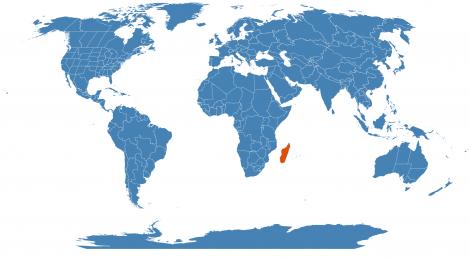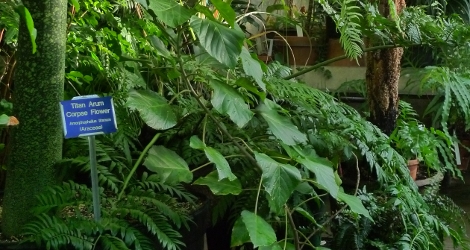Accession Data:
Rhipsalis baccifera ssp. horrida (Baker) Barthlott
subg. Rhipsalis
- Common Name: Mouse Tail Cactus
- Family: Cactaceae Juss.
- Country of Origin: Madagascar (endemic)

- Habitat: ssp. horrida is limited to rock outcrops exposed to full sun
- Description: R. baccifera has a range that includes much of the new world tropics, as well as the old world tropics from Africa east to Sri Lanka. It is the only cactus species found naturally outside of the Americas. Subspecies horrida is a polyploid form endemic to Madagascar.
There is evidence that Rhipsalis was not introduced into the palaeotropics by man, and that the palaeotropical evolutionary centre of the genus is Madagascar (Barthlott,1983)
It is worth mentioning that, in contrast to the diploid neotropical Rhipsalis species, the palaeotropical representatives of the genus are tetra- to octoploid.(Barthlott,1983)
Accession Data:
- Accession # 200202465
- Source: Matt Opel
- Accession Date: 10-23-2002
- Bench: 2203 - XER:Spiny Thicket/Socotra/S Africa
- Currently: active - healthy
- Qty: 2 confirmed on 03-19-2025
- Restrictions:
- CITES Appendix II Listed Plant
- CITES Appendix II Listed Plant
Classification:
- Division: Magnoliophyta
- Class: Magnoliopsida
- SubClass: core eudicots
- Order: Caryophyllales
- SubOrder:
- Family: Cactaceae
- SubFamily: Cactoideae
- Tribe: Rhipsalideae
- SubTribe:
Flowering Data:
This accession has been observed in bloom on:| Year | Jan | Feb | Mar | Apr | May | Jun | Jul | Aug | Sep | Oct | Nov | Dec | ||||||||||||||||||||||||||||||||||||||||
|---|---|---|---|---|---|---|---|---|---|---|---|---|---|---|---|---|---|---|---|---|---|---|---|---|---|---|---|---|---|---|---|---|---|---|---|---|---|---|---|---|---|---|---|---|---|---|---|---|---|---|---|---|
| 2025 | ||||||||||||||||||||||||||||||||||||||||||||||||||||
| 2024 | ||||||||||||||||||||||||||||||||||||||||||||||||||||
| 2023 | ||||||||||||||||||||||||||||||||||||||||||||||||||||
| 2022 | ||||||||||||||||||||||||||||||||||||||||||||||||||||
| 2021 | ||||||||||||||||||||||||||||||||||||||||||||||||||||
| 2020 | ||||||||||||||||||||||||||||||||||||||||||||||||||||
| 2019 | ||||||||||||||||||||||||||||||||||||||||||||||||||||
| 2018 | ||||||||||||||||||||||||||||||||||||||||||||||||||||
| 2017 | ||||||||||||||||||||||||||||||||||||||||||||||||||||
| 2016 | ||||||||||||||||||||||||||||||||||||||||||||||||||||
| 2015 | ||||||||||||||||||||||||||||||||||||||||||||||||||||
| 2014 | ||||||||||||||||||||||||||||||||||||||||||||||||||||
| 2013 | ||||||||||||||||||||||||||||||||||||||||||||||||||||
| 2012 | ||||||||||||||||||||||||||||||||||||||||||||||||||||
| 2011 | ||||||||||||||||||||||||||||||||||||||||||||||||||||
| 2010 | ||||||||||||||||||||||||||||||||||||||||||||||||||||
| 2009 | ||||||||||||||||||||||||||||||||||||||||||||||||||||
| 2008 | ||||||||||||||||||||||||||||||||||||||||||||||||||||
| 2007 | ||||||||||||||||||||||||||||||||||||||||||||||||||||
| 2006 | ||||||||||||||||||||||||||||||||||||||||||||||||||||
References (internal):
- EEB Greenhouse Holdings native to: Madagascar
References (external):
- Implications of Genotypic Diversity and Phenotypic Plasticity in the Ecophysiological Success of CAM Plants, Examined by Studies on the Vegetation of Madagascar, Plant Biology, Volume 3, Issue 3(p 214-222)
data regenerated on Thu, 03 Jul 2025 15:33:24 -0400 [bcm v4.0]
Images:

Additional images for this accession:
Click on thumbnails to enlargeCurrent Accessions in the Cactaceae
Subfamily Cactoideae
Tribe Cacteae
- Ariocarpus fissuratus


- Astrophytum capricorne
- Astrophytum myriostigma


- Astrophytum ornatum W/C

- Coryphantha cornifera W/C


- Coryphantha difficilis

- Coryphantha maiz-tablasensis W/C
- Echinocactus grusonii


- Echinocactus texensis W/C
- Epithelantha micromeris W/C

- Escobaria vivipara W/C
- Ferocactus cylindraceus W/C

- Ferocactus echidne W/C
- Ferocactus glaucescens W/C
- Ferocactus glaucescens
- Ferocactus gracilis

- Ferocactus pilosus

- Leuchtenbergia principis


- Mammillaria bocasana
- Mammillaria bombycina


- Mammillaria compressa
- Mammillaria compressa
- Mammillaria glochidiata W/C


- Mammillaria gracilis ssp. minima

- Mammillaria hertrichiana W/C

- Mammillaria hertrichiana W/C

- Mammillaria magnimamma

- Mammillaria mystax

- Mammillaria parkinsonii W/C
- Mammillaria petterssonii W/C
- Mammillaria plumosa

- Mammillaria scheideana W/C


- Mammillaria uncinata W/C

- Mammilloydia candida W/C

- Ortegocactus macdougallii

- Rhipsalidopsis gaertneri



- Stenocactus crispatus W/C

- Stenocactus lamellosus W/C

- Thelocactus rinconensis W/C
- Turbinicarpus jauernigii

Subfamily Cactoideae
Tribe Cereeae
- Cereinae: Cereus forbesii
- Cereinae: Cereus hildmannianus W/C
- Cereinae: Cereus repandus

- Cereinae: Cereus repandus var. monstrosus
- Cereinae: Cipocereus bradei
- Cereinae: Disocactus flagelliformis

- Cereinae: Melocactus azureus

- Cereinae: Melocactus cf. disciformis
- Cereinae: Melocactus ernestii

- Cereinae: Melocactus intortus W/C


- Cereinae: Melocactus matanzanus

- Cereinae: Pilosocereus magnificus
- Cereinae: Pilosocereus pachycladus W/C
- Cereinae: Pilosocereus polygonus W/C

- Cereinae: Pilosocereus purpusii
- Cereinae: Pilosocereus sp.
- Rebutiinae: Browningia hertlingianus

- Rebutiinae: Gymnocalycium capillaense W/C

- Rebutiinae: Gymnocalycium gibbosum W/C
- Rebutiinae: Gymnocalycium monvillei ssp. achirasense W/C

- Rebutiinae: Gymnocalycium pflanzii W/C


- Rebutiinae: Gymnocalycium quehlianum W/C

- Rebutiinae: Rebutia minuscula W/C

- Rebutiinae: Uebelmannia pectinifera


- Trichocereinae: Acanthocalycium klimpelianum W/C

- Trichocereinae: Acanthocalycium klimpelianum W/C

- Trichocereinae: Cleistocactus baumannii ssp. santacruzensis
- Trichocereinae: Cleistocactus fieldianus W/C

- Trichocereinae: Cleistocactus strausii

- Trichocereinae: Discocactus placentiformis

- Trichocereinae: Echinopsis ancistrophora ssp. arachnacantha

- Trichocereinae: Echinopsis atacamensis W/C
- Trichocereinae: Echinopsis aurea W/C
- Trichocereinae: Echinopsis aurea W/C
- Trichocereinae: Echinopsis aurea
- Trichocereinae: Echinopsis calochlora

- Trichocereinae: Echinopsis camarguensis
- Trichocereinae: Echinopsis eyriesii
- Trichocereinae: Echinopsis subdenudata

- Trichocereinae: Echinopsis thionanthum W/C
- Trichocereinae: Espostoa ritteri W/C

- Trichocereinae: Espostoa senilis

- Trichocereinae: Haageocereus chryseus W/C

- Trichocereinae: Haageocereus salmonoides
- Trichocereinae: Harrisia regelii W/C
- Trichocereinae: Harrisia taetra W/C
- Trichocereinae: Lobivia pygmaea

- Trichocereinae: Matucana calliantha

- Trichocereinae: Matucana madisoniorum

- Trichocereinae: Oreocereus celsianus W/C
- Trichocereinae: Oreocereus cf. celsianus

- Trichocereinae: Trichocereus grandiflorus
- Trichocereinae: Weberbauerocereus rauhii W/C

Subfamily Cactoideae
Tribe Copiapoinae
- Copiapoa cinerea W/C

- Copiapoa cinerea var. haseltoniana
- Copiapoa coquimbana W/C
- Copiapoa echinoides

- Copiapoa echinoides W/C

- Copiapoa humilis
- Copiapoa hypogaea W/C
- Copiapoa laui W/C

- Copiapoa montana
- Copiapoa montana W/C
- Copiapoa unidentified
- Frailea cf. pygmaea
Subfamily Cactoideae
Tribe Notocacteae
- Neoporteriinae: Eriosyce napina W/C
- Neoporteriinae: Eulychnia breviflora W/C

- Neoporteriinae: Eulychnia breviflora
- Neoporteriinae: Eulychnia saint-pieana
- Notocactinae: Parodia comarapana

- Notocactinae: Parodia formose var. prolifera
- Notocactinae: Parodia haselbergii ssp. haselbergii

- Notocactinae: Parodia leninghausii

- Notocactinae: Parodia magnifica
- Notocactinae: Parodia ottonis
Subfamily Cactoideae
Tribe Phyllocacteae
- Corryocactinae: Neoraimondia arequipensis W/C

- Echinocereinae: Acanthocereus tetragonus
- Echinocereinae: Carnegiea gigantea W/C


- Echinocereinae: Carnegiea gigantea


- Echinocereinae: Cephalocereus euphorbioides
- Echinocereinae: Cephalocereus quadricentralis W/C
- Echinocereinae: Cephalocereus senilis


- Echinocereinae: Echinocereus cinerascens W/C
- Echinocereinae: Echinocereus nivosus

- Echinocereinae: Echinocereus pentalophus

- Echinocereinae: Echinocereus scheeri ssp. scheeri W/C
- Echinocereinae: Echinocereus subinermis

- Echinocereinae: Echinocereus subinermis ssp. ochoterenae
- Echinocereinae: Escontria chiotilla
- Echinocereinae: Lophocereus sp.
- Echinocereinae: Lophocereus schottii

- Echinocereinae: Stenocereus humilis
- Echinocereinae: Stenocereus stellatus
- Hylocereinae: Epiphyllum hookeri subsp. guatemalense


- Hylocereinae: Epiphyllum oxypetalum
- Hylocereinae: Epiphyllum phyllanthus W/C

- Hylocereinae: Hylocereus costaricensis

- Hylocereinae: Pseudorhipsalis micrantha
- Hylocereinae: Selenicereus anthonyanus
- Hylocereinae: Selenicereus chrysocardium


- Hylocereinae: Selenicereus grandiflorus

- Hylocereinae: Selenicereus wittii W/C


Subfamily Cactoideae
Tribe Rhipsalideae
- Hatiora cylindrica

- Hatiora herminiae W/C


- Hatiora salicornioides
- Lepismium cf houlletianum
- Lepismium cruciforme


- Lepismium warmingianum

- Rhipsalis baccifera ssp. horrida

- Rhipsalis burchellii
- Rhipsalis cereuscula
- Rhipsalis cf rhombea
- Rhipsalis elliptica


- Rhipsalis juengeri

- Rhipsalis lorentziana W/C

- Rhipsalis mesembryanthemoides


- Rhipsalis oblonga


- Rhipsalis pachyptera


- Rhipsalis paradoxa


- Rhipsalis pentaptera


- Rhipsalis pilocarpa
- Rhipsalis teres


Subfamily Cactoideae
Tribe Trichocereeae
Subfamily Maihuenioideae
Subfamily Opuntioideae
Tribe Austrocylindropuntieae
Subfamily Opuntioideae
Tribe Cylindropuntieae
Subfamily Opuntioideae
Tribe Opuntieae
- Opuntia brasiliensis

- Opuntia fragilis

- Opuntia humifusa W/C

- Opuntia microdasys "Monstrose"

- Opuntia microdasys

- Opuntia microdasys var. lutea
- Opuntia microdasys ssp. rufida
- Opuntia picardoi
- Opuntia pycnantha

- Opuntia quitensis
- Opuntia schickendantzii
- Opuntia sp.

Subfamily Opuntioideae
Tribe Tephrocacteae
Subfamily Pereskioideae
Tribe Pereskieae
W/C = Wild Collected
 = indicates flowering in past 14 days
= indicates flowering in past 14 days
 = images available for this accession
= images available for this accession
 = map available for this accession
= map available for this accession
 = accession added within past 90 days
= accession added within past 90 days